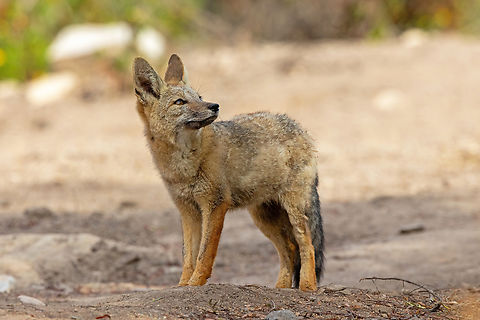
Appearance
The culpeo is a canid intermediate in size between a red fox and a coyote. It is the second-largest native canid on the continent after the maned wolf. In appearance, it bears many similarities to the widely recognized red fox. It has grey and reddish fur, a white chin, reddish legs and a stripe on its back that may be barely visible. The average weight of the male is 11.4 kg, while the typically smaller females average 8.4 kg. Overall, a weight range of 5 to 13.5 kg has been reported. Total length can range from 94 to 133 cm, including a tail of 32 to 44 cm in length. The pelt has a grizzled appearance. The neck and shoulders are often tawny to rufous in color, while the upper back is dark. The bushy tail has a black tip.Habitat
The culpeo lives in a wide variety of habitats of western South America. They are found in broadleaf "Nothofagus" temperate rainforest, sclerophyllous matorral, deserts, chaparrals, and plateaus, like the Altiplano, up to the tree line ).Reproduction
The typical mating period is between August and October. After a gestation period of 55–60 days, the female gives birth usually to between two and five pups.Food
The culpeo is an opportunistic predator that will take any variety of prey. It mainly feeds on rodents and lagomorphs; however, it occasionally feeds on domestic livestock and young guanacos. They will also feed on insects, birds, lizards, fruit, and carrion of llamas and vicuñas. Culpeos are considered beneficial because they are significant predators of the rabbits introduced in 1915; such introduced rabbit populations are believed to have allowed culpeos to spread from the Andean foothills across the Patagonian plain. They sometimes take young lambs up to 1 week old. In limited studies, the larger culpeo appears to dominate potential competitors, including South American gray foxes, Geoffroy's cats, pampas cats, grisons and various raptorial birds. In the southeastern Argentine Patagonia region, culpeos generally tend to consume more of the introduced European hare than the South American gray fox does year-round, while the gray fox tends to consume more rodents. However, during colder seasons, the culpeo's diet overlaps more with the gray fox due to a lack of variety in prey, thus causing prey partitioning as the culpeos use their size advantage to exclude the gray fox from areas with higher concentrations of prey. Its range also overlaps that of the much larger puma, but the size difference ensures that the two species have limited competition. They are known to eat the carcasses of vicuñas. Culpeos have also been observed preying upon introduced beavers in Tierra del Fuego.During a period of drought in central Chile's scrublands lagomorphs, coati, goats, and cattle make up a large amount of their diet.
References:
Some text fragments are auto parsed from Wikipedia.